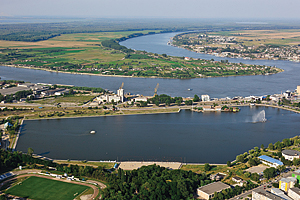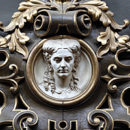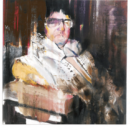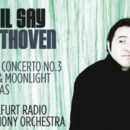
A SPACE OF FORBEARANCE
When I was nine my parents moved to Tulcea, a town of perhaps 75,000 people at the time, located at the very entrance in the Danube Delta, some 150 miles east of Bucharest. With a Romanian father from Transilvania and a Ukrainian mother from a village of refugees located 45 km east from Tulcea, two languages spoken in the family, and two rounds of religious celebrations, I myself was open, or at least prepared for ethnic diversity.
Tulcea was the grounds for solid training in ethnic, religious and cultural diversity: a rather cosmopolitan place, with a miriad of ethnic groups living together without any ample conflict in what was, before 1877, within the borders of the Ottoman Empire.
CHURCH. SYNAGOGUE
On my way to high school, I passed the Catholic Church, catching timid glimpses of its interior and snatches of organ music when the door was ajar. I could then see a plaster statue of Christ in the half-shade of the vernacular gothic atmosphere. A little closer to the center, the Greek Orthodox Church followed; a towerless “temple”: the cathedral of St.Nicholas right next to it had enough height for both of them. In the city center there was a Bulgarian orthodox church: now that had a clock and a strange Romanesque nave. Very near to there I could see the synagogue, and en route to my school I used to take a short-cut through the courtyard of the Lippovan church, Decorated in green oilbased paint outside, like many of their houses, and adorned with crêpe papier on feast days. Its icons were mounted in brass and silver; the Lippovan women, wearing gowns and kerchiefs in deliriously rich colors, walked in a stately parade behind their husbands, who
wore rubashka (Russian tunics), with their beards hanging down to their belts. Then I would reach the bluffs of the Danube. It was a poetic setting, but to promenade on the bluffs (faleza in Romanian, but also corso) was to parade and to display your family status. The bluffs were not only the spines of the town, but also its most interesting site. Social contacts, promenades, urban life – everything happened there.
That was, of course, more or less until Ceaușescu started an ample program to change the administrative geography of Romania. Tulcea became the county “capital”, a “municipium”, and saw its urban core demolished and rebuilt, with a major edifice for administration headquarters, a “house of culture of the workers’ union”, a supermarket and perhaps several blocks of flats.
place, with a miriad of ethnic groups living together without any ample conflict in what was, before 1877, within the borders of the Ottoman Empire. At the extreme east end of the Danube bluffs is the great mosque of Tulcea, whose minaret (tower) no church steeple was allowed to surpass in height. That was the only religious restriction imposed on the Christians during the Turkish empire. However, since the mosque is located at the lowest point in the city, whereas the churches are spread over the seven hills of the town, it was not an easy task to match the height requirement.
Afterwards, all the churches raised their spires “against” the monumental mosque, which was still in use when my parents and I arrived in the city. Let’s take a look at the outline of the city from west to east: first, the spires of the Orthodox Church in the Heroes’ Cemetery; then the Lippovan church near the Old Market; the Greek church and St.Nicholas Cathedral, then
the two Lippova churches set next to each other on the Hora Hill; finally, the minaret of the mosque from where the muezin would still utter his calls when I was an adolescent: we could still hear his plaintiff tone from the terrace of “Little Carnation”, a sweet shop where one could eat the best rose ice cream in the world; its recipe left this earth along with the Turk who used to make it.
The city used to live in peace, a slightly sleepy collection of ethnic groups at the margins of history, enjoying their borsch , braga , tsatsiki , Turkish/Greek coffee, vodka and fish. Only our memories can still recover some of the old city; relatives and friends, speaking strange languages and behaving nicely to each other, have gone away or died. They did so only after they having indelibly shaped my sense of togetherness and of lived space.
The reconstruction might require though some sort of kick-start: dynamite to get rid of the block of flats, incentives for those who invest in tourism and services; support for the local stone, brick and adobe factories and for those who want to build or rebuild their own houses.
Decent national politics, perhaps a little more curiosity from the Western world. And some patience. As in hologram, the patched town architecture could still be reconstructed – it is only twenty years away from here/now. It can reinvent itself along the same stable paths of coexistence and space domestication.









